Just east of El Paso, Hueco Tanks State Park and Historic Site protects the low-lying mountains that rise out the Chihuahuan Desert. Hueco Tanks holds a unique concentration of animals, plants and historical artifacts that make it unlike anywhere else in the desert Southwest. Below are seven reasons why Hueco Tanks is a special place.
1. “Huecos” aren’t in Waco, Texas
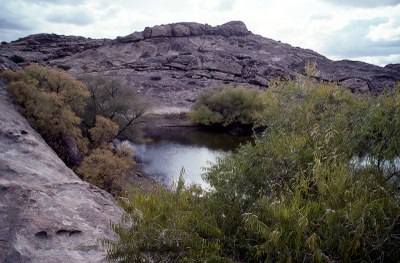
Water-filled basin in Hueco Tanks. Photo courtesy of Texas State Parks and Wildlife.
It would be easy for any Texan to confuse “Waco” and “hueco,” but although they sound the same, huecos are something different than the central Texas city. Meaning “hollows,” huecos are the igneous rock formations that collect rainwater, and – depending on the size of the hole and whether or it is protected from evaporation – hold it for days or weeks at a time.
2. The desert oasis is home to a variety of wildlife

One of the 17 species of lizards found in the park. Photo courtesy of Texas State Parks and Wildlife.
The relative abundance of water creates “microhabitats” that allow animals that would not normally be found in the desert to thrive in the park. Carnivores like bobcat, gray fox, coyote, javelina, raccoon and mountain lion are present. Rabbits, rodents, and reptiles make their homes in Hueco Tanks as well. Twenty five species of snakes live in the park, including five types of rattlesnakes, joining 17 species of lizards. More than 200 species of birds have been recorded at Hueco Tanks, making birding a popular activity.
3. Humans are no strangers to Hueco Tanks

Numerous Native American tribes, like the Mescalero Apache, consider Hueco Tanks to be a meaningful part of their heritage. Photo courtesy of Texas State Parks and Wildlife.
For some 10,000 years people have made use of the water, food and shelter Hueco Tanks provides, an oasis in an otherwise unforgiving desert. Early hunter-gatherers found prey and used the desert plants for food, fiber and medicine. By 1150 A.D., the Jornada Mogollon people began farming at Hueco Tanks, using the water collected in the basin. Native Americans continued to use the site after the arrival of the Spanish. In the following centuries, the gold-seekers, cattle drover and surveyors left their mark on the land.
4. Hueco Tanks is home to thousands of pictographs
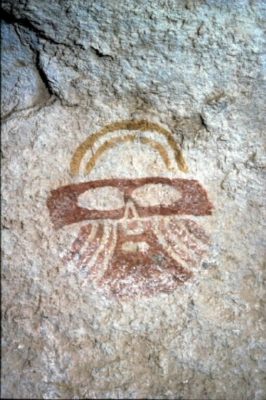
One of Hueco Tanks thousands of pictographs. Photo courtesy of Texas State Parks and Wildlife.
Thousands of pictographs depict hand-prints, snakes, dancing figures, humans, weapons and horses, and many other shapes. The most renowned images are what archaeologists call “masks” or face designs. Left by the Jornada Mogollon people, this type of rock art is rare, and Hueco Tanks has more than 200, making it the largest concentration in North America.
5. Even without art, the rocks are special
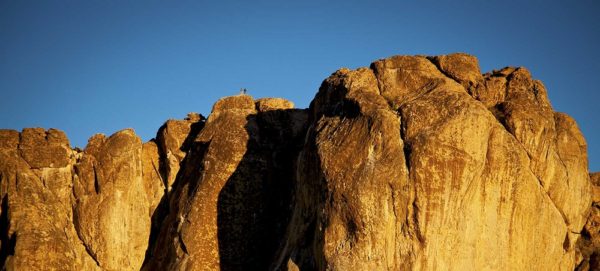
The igneous rock formations as seen at dusk. Photo courtesy of Texas State Parks and Wildlife.
The three low mountains in the park were formed about 35 million years ago. A mass of hot molten magma was pushed upward, where it cooled under a layer of limestone. Over millions of years, the limestone was worn away, by wind and water. The under-layer of igneous rock was exposed, and then shaped into the formations seen today by water and wind.
6. Hueco Tanks is home to world-class rock climbing
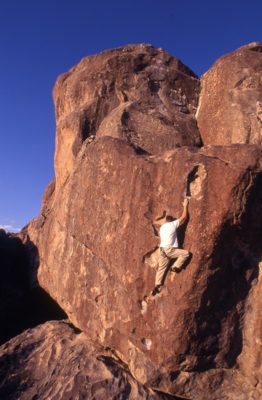
Thousands of climbers visit each year. Photo courtesy of Texas State Parks and Wildlife.
Recognized as one of best places to climb in the world, the particular type of climbing popular at Hueco Tanks is called “bouldering,” where the climb is low enough to attempt without ropes. During the busy season from October to March, the park hosts hundreds of climbers. Each February, the park hosts “Hueco Rock Rodeo,” an outdoor bouldering competition attended by professional climbers from all around the world.
7. To protect the park, access is limited
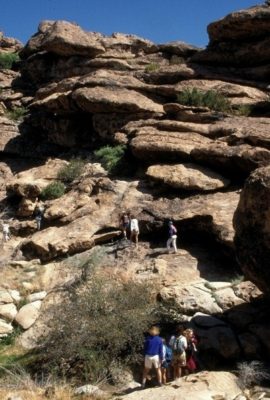
Self-guided areas, like this trail, are limited to 70 people at a time. Photo courtesy of Texas State Parks and Wildlife.
Due to the fragile nature of the pictographs and the plants and animals, access to the park is limited. Because of rampant graffiti and overcrowding causing issues, the park implemented a public use plan that restricts access to more than two thirds of the park, with access only allowed with a volunteer or commercial guide. To enter the self-guided areas of the park, visitors must watch an orientation video. Access to the self-guided area is limited to only 70 people per day, so reservations are recommended.
